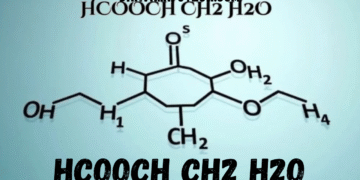HCOOCH CH2 H2O is an organic compound that reflects a combination of formate, methylene, and water elements, symbolizing an interaction between an organic acid derivative and a hydrated group. The structure implies a compound that may form through esterification or condensation reactions involving formic acid and other simple organic molecules. This chemical blend represents a hybrid of reactivity and stability, making it an interesting subject for chemists studying reaction dynamics and organic transformations. It embodies the molecular bridge between formic acid and methanol derivatives, displaying a rich pattern of hydrogen bonding and weak intermolecular interactions that define its chemical essence.
Molecular Structure and Bonding Characteristics of HCOOCH CH2 H2O

The structure of HCOOCH CH2 H2O contains both polar and non-polar regions, giving it unique solubility and bonding features. The HCOO group contributes oxygen atoms capable of forming hydrogen bonds with the H2O molecule, which stabilizes the compound in aqueous media. The CH2 fragment introduces flexibility, enabling rotational freedom within the molecule. This dual property of hydrogen bonding and structural movement makes HCOOCH CH2 H2O reactive in controlled conditions, often taking part in hydrolysis or oxidation-reduction reactions. The presence of water molecules assists in maintaining equilibrium, preventing the compound from rapid decomposition or polymerization.
Physical Properties and Observable Behavior of HCOOCH CH2 H2O
Physically, HCOOCH CH2 H2O may appear as a colorless to pale liquid or crystalline solid depending on its hydration level and temperature. It exhibits a moderate boiling point, indicating intermolecular attraction influenced by hydrogen bonding. When exposed to air, the compound may gradually release a mild odor resembling formic acid or esters. **Its density, viscosity, and polarity are strongly governed by the amount
The Chemical Identity and Concept of HCOOCH CH2 H2O
HCOOCH CH2 H2O is a unique organic compound combining the structural features of formate, methylene, and water-based components, creating a balanced system between organic acid and hydrated molecules. It is often studied in organic chemistry as a representative compound illustrating esterification and hydrolysis reactions in equilibrium. This molecular combination exhibits distinct chemical characteristics because of the dual presence of oxygen and hydrogen atoms, which influence its reactivity, polarity, and stability in different chemical environments. It acts as a model compound for examining the link between formic acid derivatives and simple organic alcohols, making it valuable for academic and industrial chemistry studies.
Structural Framework and Molecular Interaction of HCOOCH CH2 H2O

The molecular structure of HCOOCH CH2 H2O demonstrates a delicate balance between ionic and covalent forces. The HCOO group (formate) provides polarity through carbon–oxygen double bonding, while CH2 contributes to the compound’s organic backbone, creating flexibility and mobility within its molecular design. Water (H2O) enhances intermolecular hydrogen bonding, stabilizing the molecule and influencing its reactivity in aqueous solutions. This combination of structural elements results in a compound capable of participating in multiple reaction pathways, including condensation and oxidation processes, essential in organic synthesis and industrial chemistry.
Physical and Chemical Properties of HCOOCH CH2 H2O
The compound HCOOCH CH2 H2O exists primarily in liquid or semi-hydrated crystalline forms, depending on temperature and surrounding conditions. It possesses moderate volatility, a characteristic ester-like odor, and solubility in polar solvents due to hydrogen bonding. Chemically, it can undergo slow decomposition when heated, forming simpler molecules like CO2, CO, and water vapor. Its chemical reactivity is influenced by pH levels, where acidic or basic environments can alter its structural configuration, leading to hydrolysis or further condensation reactions.
Reaction Mechanisms and Behavior of HCOOCH CH2 H2O
HCOOCH CH2 H2O takes part in various chemical reactions, notably esterification, hydrolysis, and oxidation. In the presence of acids or bases, it can hydrolyze to form formic acid and formaldehyde derivatives. When oxidized under controlled laboratory conditions, it yields carbon dioxide and other organic byproducts, showing its reactive nature. These reactions are important for understanding molecular transformation mechanisms and are widely used to illustrate organic reaction theories in advanced chemistry.
Industrial and Laboratory Applications of HCOOCH CH2 H2O

In industry and research, HCOOCH CH2 H2O has importance as a chemical intermediate, solvent, and model compound for studying formate chemistry. It plays a role in developing bio-based fuels, polymer precursors, and fragrance manufacturing. In laboratories, it is used in controlled experiments to observe hydrolysis rates, catalyst performance, and solvent interactions. The compound’s hybrid nature allows scientists to simulate complex organic behaviors in simpler systems, providing insight into real-world industrial reactions.
Environmental Interaction and Decomposition Patterns of HCOOCH CH2 H2O
When exposed to environmental conditions such as sunlight or air, HCOOCH CH2 H2O gradually breaks down into simpler carbon compounds. The decomposition is typically non-toxic, releasing carbon dioxide and water as end products. Its biodegradability makes it suitable for eco-friendly applications, particularly in green chemistry and sustainable solvent systems. The environmental fate of this compound highlights its compatibility with nature and minimal long-term residue effects, promoting safe use across industries.
Experimental Studies and Research Value of HCOOCH CH2 H2O
Scientists have conducted extensive experiments on HCOOCH CH2 H2O to explore its reaction kinetics, molecular stability, and thermodynamic properties. The results show its versatile nature as a research compound suitable for testing catalysts, energy storage reactions, and organic transformation patterns. It also serves as an educational example for chemistry students to understand hydration, ester formation, and intermolecular bonding. In recent studies, HCOOCH CH2 H2O has been evaluated for its potential use in sustainable energy models and bioreactor systems.
Safety and Handling Considerations of HCOOCH CH2 H2O
Though relatively mild, HCOOCH CH2 H2O should be handled with care, avoiding prolonged exposure to open air or heat sources. In laboratory use, it requires appropriate storage in sealed containers to prevent unwanted hydrolysis or evaporation. Safety measures include using gloves, goggles, and proper ventilation during experiments. Its low toxicity profile allows safe disposal after neutralization, but large-scale handling still requires adherence to chemical safety protocols to maintain laboratory and environmental integrity.
Importance of HCOOCH CH2 H2O in Modern Chemistry
The significance of HCOOCH CH2 H2O extends beyond its structural form—it represents a bridge between simple and complex organic systems. Chemists utilize it to explore reaction mechanisms, molecular modeling, and the role of water in stabilizing reactive organic compounds. In educational contexts, it helps explain core organic principles such as ester formation, hydrogen bonding, and solvent effects. Its balanced reactivity makes it an ideal compound for experiments demonstrating the foundation of organic chemistry and applied industrial processes.
Conclusion
In conclusion, HCOOCH CH2 H2O stands as a remarkable compound illustrating the harmony between organic molecules and water’s stabilizing power. Its role in hydrolysis, esterification, and oxidation showcases its versatility and importance across laboratory, educational, and industrial platforms. Its environmentally compatible nature and scientific utility make it a valuable part of modern chemical research.
FAQs
Q1: What is HCOOCH CH2 H2O used for?
It is used in research, solvent systems, and chemical synthesis.
Q2: Is HCOOCH CH2 H2O stable?
Yes, it is moderately stable under normal temperature but decomposes on heating.
Q3: Can HCOOCH CH2 H2O be used in green chemistry?
Yes, its biodegradability and low toxicity make it suitable for eco-friendly applications.
Q4: What reactions does HCOOCH CH2 H2O undergo?
It primarily undergoes hydrolysis, oxidation, and esterification reactions.
Q5: Why is HCOOCH CH2 H2O important in organic chemistry?
Because it demonstrates the relationship between formate compounds, water, and reaction dynamics.
Read More: Ingredients in Wullkozvelex – Understanding What Makes It Work






















